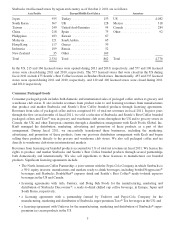Starbucks 2011 Annual Report Download - page 21
Download and view the complete annual report
Please find page 21 of the 2011 Starbucks annual report below. You can navigate through the pages in the report by either clicking on the pages listed below, or by using the keyword search tool below to find specific information within the annual report.•Effectively managing growth both in our retail store business and our global consumer products business is
challenging and places significant strain on our management and employees and our operational, financial,
and other resources.
Effectively managing growth can be challenging, particularly as we continue to expand into new channels outside
the retail store model, increase our focus on our global consumer products business, and expand into new markets
internationally where we must balance the need for flexibility and a degree of autonomy for local management
against the need for consistency with our goals, philosophy and standards. Growth can make it increasingly difficult
to ensure a consistent supply of high quality raw materials, to locate and hire sufficient numbers of key employees,
to maintain an effective system of internal controls for a globally dispersed enterprise and to train employees
worldwide to deliver a consistently high quality product and customer experience.
•If we pursue strategic acquisitions, divestitures or joint ventures, we may not be able to successfully
consummate favorable transactions or successfully integrate acquired businesses.
From time to time we may evaluate potential acquisitions, divestitures, or joint ventures with third parties. These
transactions create risks such as:
• disruption of our ongoing business, including loss of management focus on existing businesses;
• problems retaining key personnel;
• operating losses and expenses of the businesses we acquire or in which we invest;
• the potential impairment of tangible assets, intangible assets and goodwill acquired in the acquisitions;
• the difficulty of incorporating an acquired business into our business and unanticipated expenses related to
such integration; and
• potential unknown liabilities associated with a business we acquire or in which we invest
In the event of any future acquisitions, we might need to issue additional equity securities, spend our cash, incur
debt, or take on contingent liabilities, any of which could reduce our profitability and harm our business.
•We rely heavily on information technology in our operations, and any material failure, inadequacy,
interruption or security failure of that technology could harm our ability to effectively operate our business.
We rely heavily on information technology systems across our operations, including for management of our supply
chain, point-of-sale processing in our stores, Starbucks Cards, online business and various other processes and
transactions. Our ability to effectively manage our business and coordinate the production, distribution and sale of
our products depends significantly on the reliability and capacity of these systems. The failure of these systems to
operate effectively, problems with transitioning to upgraded or replacement systems, or a breach in security of these
systems could cause delays in product sales and reduced efficiency of our operations, and significant capital
investments could be required to remediate the problem. Security breaches of our employees or customer private
data could also adversely impact our reputation, and could result in litigation against us or the imposition of
penalties,
•Failure to comply with applicable laws and regulations could harm our business and financial results.
Our policies and procedures are designed to comply with all applicable laws, accounting and reporting requirements,
regulations and tax requirements, including those imposed by the SEC, NASDAQ, and foreign countries, as well as
applicable trade, labor, privacy, food, anti-bribery and corruption and merchandise laws. The complexity of the
regulatory environment in which we operate and the related cost of compliance are both increasing due to additional
legal and regulatory requirements, our ongoing expansion into new markets and new channels, together with the fact
that foreign laws occasionally conflict with domestic laws. Failure to comply with the various laws and regulations
as well as changes in laws and regulations or the manner in which they are interpreted or applied, may result in
damage to our reputation, civil and criminal liability, damages, fines and penalties, increased cost of regulatory
compliance and restatements of our financial statements.
15
























